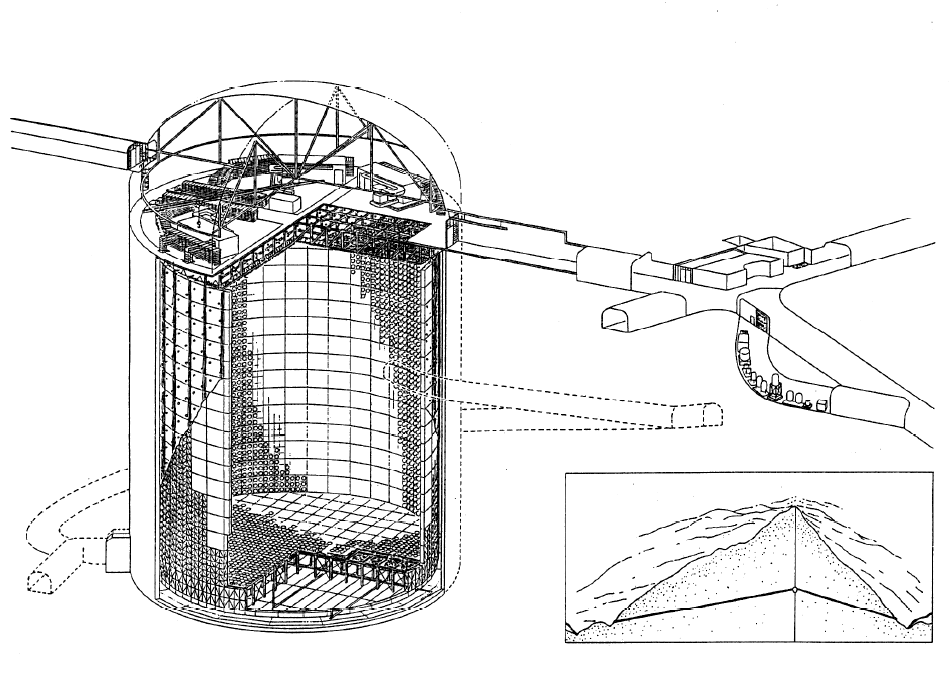|
|
|||
|
36°20'24"N, 137°19'48"E ..
Super-Kamiokande, or Super-K for short, is a neutrino observatory in Japan. The observatory was designed to study solar neutrinos, study atmospheric neutrinos, search for proton decay, and detect neutrinos from a supernova anywhere in our galaxy. Super-K is located 1,000 m underground in Mozumi Mine of the Kamioka Mining and Smelting Co. in Kamioka-cho, Gifu, Japan. It consists of 50,000 tons of pure water surrounded by about 11000 photomultiplier tubes. The cylindrical structure is 40 m tall and 40 m across. A neutrino interaction with the electrons or nuclei of water can produce a particle that move faster than the speed of light in water (although of course slower than the speed of light in vacuum). This creates a flash of light due to Cherenkov radiation which is the optical equivalent to a sonic boom. The distinct pattern of this flash provides information on the direction and flavor of the incoming neutrino. History Construction of Kamioka Underground Observatory, the predecessor of the present Kamioka Observatory, Institute for Cosmic Ray Research, University of Tokyo began in 1982 and was completed in April, 1983. The purpose of the observatory was to detect the proton decay, one of the most fundamental questions of elementary particle physics. The detector, named KAMIOKANDE for Kamioka Nucleon Decay Experiment, was a tank which contained 3,000 tons of pure water and had about 1,000 photomultiplier tubes (PMTs) attached to the inner surface. The size of the tank was 16.0 m in height and 15.6 m in diameter. An upgrade of the detector was started in 1985 to observe neutrinos of cosmic origin. As a result, the detector had become hightly sensitive and had succeeded in detecting neutrinos from a supernova explosion which was observed from in the Large Magellanic Cloud in Febrary 1987. Solar neutrinos were observed in 1988 adding to the advancements in neutrino astronomy and neutrino astrophysics.
top of the pure water. Water is used because of its excellent cost/refractive index ratio Despite its success in neutrino observation, Kamiokande
could not detect the proton
decay, its first aim. Also, even higher sensitivity was in need to
observe neutrinos in high statistics confidence. This lead to the construction
of Super-Kamiokande, with ten times more water volume and PMTs than Kamiokande.
Super-Kamiokande started observation in 1996.
Super-Kamiokande Collaboration announced the first evidence of neutrino oscillations in 1998, which means neutrino has non-zero mass. Until this, all observational evidences were consistent with neutrinos being massless, although theorists had speculated on the possibility of neutrinos having non-zero mass for many years. On November 12, 2001, several thousand photomultiplier tubes in the Super-Kamiokande detector imploded, apparently in a chain reaction as the pressure waves from each imploding tube cracked its neighbours. The detector has been partially restored with about 5000 photomultiplier tubes with protective shells that will prevent the chain reaction from recurring.
Cerenkov effect | Cerenkov radiation | Cherenkov effect | Cherenkov radiation | Electron neutrino | Koshiba Masatoshi | List of Japan-related topics L-Z | List of physics topics R-Z | Masatoshi Koshiba | Muon neutrino | Neutrino | Neutrino oscillation | Neutrinos | Particle physics standard model | Proton decay | Solar neutrino problem | Standard Model | Tau neutrino License:
History:
|
|||
| FAIR USE NOTICE: This page contains copyrighted material the use of which has not been specifically authorized by the copyright owner. Pegasus Research Consortium distributes this material without profit to those who have expressed a prior interest in receiving the included information for research and educational purposes. We believe this constitutes a fair use of any such copyrighted material as provided for in 17 U.S.C § 107. If you wish to use copyrighted material from this site for purposes of your own that go beyond fair use, you must obtain permission from the copyright owner. | |||
|
|



